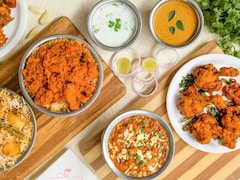If there is one thing that you will find in every Indian kitchen, it is an iron kadhai. This black-coloured utensil is often passed down from one generation to another and is still extensively used to make a wide variety of dishes. No matter how much access we have to new cookware, we still somehow end up going back to our traditional ways of cooking. While most people think that cooking in an iron kadhai is quite healthy and adds to the nutrition and taste, this is not quite the case. There are certain foods that you should avoid cooking in an iron kadhai as they may trigger food reactions and ruin the overall taste and texture of the dish you're cooking. But before we take a look at the foods we should avoid cooking in an iron kadhai let's understand the difference between iron kadhai and cast iron kadhai.
Iron Kadhai Vs Cast Iron Kadhai: What's The Difference?
The main difference between iron and cast iron kadhai is the type of material they are made from. As the name suggests, an iron kadhai is made from iron, while cast iron kadhai is made from a mixture of iron, carbon, and silicon. Cast iron kadhai also has a higher heat retention capacity than iron kadhai.
Also Read: Difference Between Iron And Cast Iron Kadhai: How To Clean Cast Iron Kadhai
Here Are 5 Foods You Should Avoid Cooking In An Iron Kadhai:
1. Tomato
Tomatoes are a key element in Indian cooking. They are used to make the masala base of a wide variety of curries and are also essential ingredients for preparing the tadka. However, since tomatoes are acidic in nature, they may trigger reactions and cause the metal to leach into the food. This would give a metallic taste to your dish, spoiling its flavour. Other acidic foods such as lemon and vinegar should also be avoided.
2. Eggs
If you're someone who often uses an iron kadhai to cook eggs, it's time to stop. The sulphur present in eggs can react with the iron, causing them to turn grey and giving them an unappetising taste. Not only that, the reaction between iron and sulphur could also make your kadhai rust and discoloured, affecting its longevity. Therefore, you should use non-stick cookware to make egg-based dishes.
3. Fish
Another food you should avoid cooking in an iron kadhai is fish. The acids present in fish can react with the iron, causing it to stick to the bottom of the pan and alter its taste and texture. If you are planning to cook fish, it's best to use non-reactive cookware, such as non-stick pans or stainless steel.
Also Read: How To Clean Copper And Brass Utensils: An Easy And Effective Solution
4. Rice
Do you cook your rice in an iron kadhi? We suggest you stop now! This is because the high acidity in the rice can react with the iron, leading to discolouration and a metallic taste. The iron could also react with the natural oils present in rice, causing it to stick to the bottom of the pan. Therefore, it's best to avoid using an iron kadhai when cooking rice and opt for a heavy-bottomed pot made with stainless steel or other non-stick cookware.
5. Pasta
Many of us are not aware that cooking pasta in an iron kadhai is not healthy, especially when making a pasta dish with a tomato-based sauce. This is because the acidity of the tomatoes can cause the iron to react, which is not ideal. Furthermore, iron kadhai tends to retain heat for a longer period of time, which can cause your pasta to overcook or stick to the bottom of the pan.
So, now that you know of these foods, take the necessary steps and avoid cooking them in an iron kadhai.
